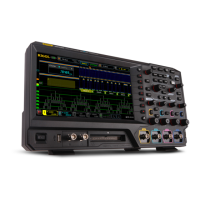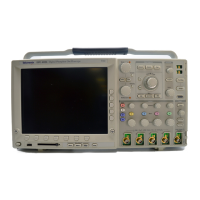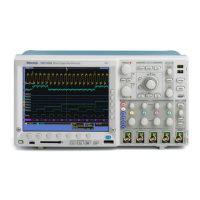Commands Listed in Alphabetical Order
Channel offset
adjusts the vertical acquisition window (moves the DC level
around which the signal is sampled) for the selected channel. Visualize offset as
scrolling the acquisition window towards the top of a large signal (or one with a
positive DC bias) for increased offset values and scrolling towards the bottom for
decreased offset values. Optimal vertical accuracy (of the entire signal) is obtained
when the offset is set to the average DC bias of the input signal (that is, when it
centers the
signal around the input dynamic range of the sampling module).
The range and resolution of offset values for a given channel is dependent on
multiple f
actors: the sampling module type (specifically, its input dynamic range),
the probe type (if attached), the e xternal attenuation factor, the selected units (if
TDR is active), and the scale.
For more information on how offset ranges are determined, refer to the topic
Vertical Offset in the online help for your instrument.
Group
Vertical
Syntax
CH<x>:OFFSet <NR3>
CH<x>:OFFSet?
Related Commands
CH<x>:POSition
Arguments
NR3 is the offset value for the specified channel; the range is ±1.6 V.
Examples
CH4:OFFSET 2.0E-3 sets the offset for Channel 4 to 2 m V.
CH3:OFFSET? might return CH3:OFFSET 0.100000000000, indicating that the
offset for Channel 3 is set to 100 mV.
CH<x>:POSition
This command sets or queries the vertical position of the specified channel. The
channel is specified by x, which can be 1 through 8. Sending this command is the
equivalent to setting Position in the Setup section of the Vertical Setup dialog box
or adjusting the front-panel Vertical Position knob.
Increasing the position value of a waveform causes the waveform to move up,
and decreasing the position value causes the waveform to move down. Position
adjusts only the display position o f a channel, math, or reference waveform.
Group
Vertical
2-86 DSA/CSA/TDS8X00/B Series Programmer Manual

